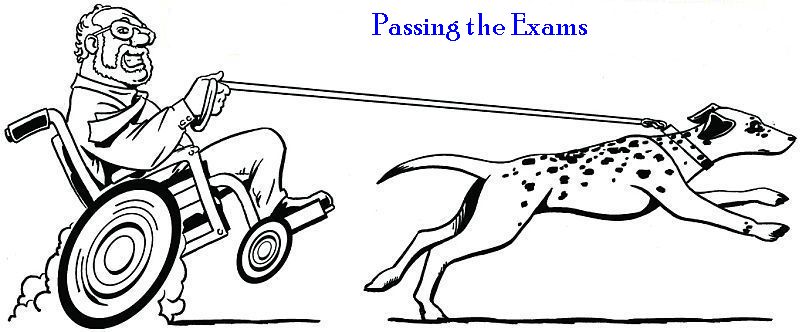|
Advice from a Teacher

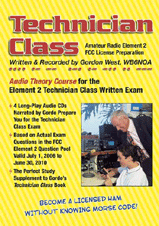 At the suggestion of the hams we met when we began "re-entry" into the hobby, we purchased Gordon West's book as a study guide for the license exam. We bought it at Radio Shack, but it's available from a number of sources (although no longer from Radio Shack). At the suggestion of the hams we met when we began "re-entry" into the hobby, we purchased Gordon West's book as a study guide for the license exam. We bought it at Radio Shack, but it's available from a number of sources (although no longer from Radio Shack).
There are other materials available — the chief competitor is the ARRL's book. If your learning style is different, there are CD's, software and videos available as well (I will not comment on these, as I haven't used them, and am not going to buy a copy just for that — we'll see if anyone reads this and wants to comment or send a review copy!). A list of various resources is available from AC6V's site.
A cautionary note: watch the dates on any material you use. The material used in the exams changes periodically. Anything you use should have the effective date and the expiration date on it. Some stores have been known to sell old editions of the books mentioned here!
If you are not an independent learner, some clubs offer classes. This is certainly a great way to pick up the material, and you can ask questions, too. Make sure that you can ask a question of the instructor or someone if you have a question later on.
All of these resources deal with the same material: a fixed pool of questions and possible answers from which the exam must be constructed (you can get the question pool from the ARRL). Note that the questions change periodically, so make sure you get a copy that is current and will remain so long enough that you can study them.
We won't go into the details of the exam process. They are detailed in all of the study guides. We will emphasize that you must pass the exams in order: Technician first, then General, then Extra. You can take all three in one exam session as long as you keep passing.

Our attitude is that what you need to do is pass the exam — that means learn how the exam works and how to get the right answers. It's a necessary step, but it does not "make" you an amateur radio operator. It's the beginning of a journey. Remember your first driver's license? The same idea is at work here. After you pass, you need to keep learning.
For some people, it is certainly possible to memorize the answers and pass the exam. After all, the question pool and answers are all fixed. If you are one of those people, look elsewhere — although you probably don't need any help if you're capable of that feat.
We find it useful to understand the processes involved in both radio and exam construction, and build from that. When you understand what is going on with a question, your knowledge is more certain. That's another way of saying that when you open the test booklet, you won't freeze up and forget everything.
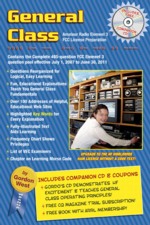 One of the things we like about West is that he gives the answers and explains what is behind the question. Sometimes he over-explains or gets onto a side track, so part of our response to his advice of "work the book" is to mark out irrelevant material (we don't object to meeting him on the air, but that didn't help us pass the exam). West's earlier editions simply went through the question pool in order. New editions are organized by topic, which is generally helpful. There's an index of the questions in back, so you can find help on anything that gives you trouble. One of the things we like about West is that he gives the answers and explains what is behind the question. Sometimes he over-explains or gets onto a side track, so part of our response to his advice of "work the book" is to mark out irrelevant material (we don't object to meeting him on the air, but that didn't help us pass the exam). West's earlier editions simply went through the question pool in order. New editions are organized by topic, which is generally helpful. There's an index of the questions in back, so you can find help on anything that gives you trouble.
Just as I take Ham Radio for Dummies to task (in the book reviews) for sometimes being an ARRL ad, I must do the same here, except that it's W5YI. There are frequent "tips" that include calling W5YI to order something. As with the other books, there's nothing wrong with that, but all that you probably really need is the book in hand. Save your money and time — get through the exam and then pursue the other areas as you build on experience.
We did find it useful to have a copy of the question pool. This helps you understand the structure of the exam, and to see how some of the questions link together. Another useful resource comes from Dan Romanchik, KB6NU. He has produced study guides with the information that comprises the exam answers (along with some background). These guides work especially well for sorting out what you need to know. They are also good for reinforcement or quick study. However, for the way most people take a test, especially one where the question and answer pool is available, you need to be familiar with the wrong answers as much as the right information. These guides are available as Adobe PDF's.

The first step is to read through all of the questions. Some of them may appear ridiculously easy, but they still merit your attention. Depending on your knowledge of government regulations, physics, and electronics, or your analytical style, some of the answers will come to you quickly. Others will take more work. On a second reading, we made notes, looking for links and similarities, trying to understand the principles functioning behind the material.
As noted earlier, we hope you'll strive to understand what's going on. That way you'll be ready to encounter with new situations. We're not going to spell everything out (but will consider addressing frequent problems) because the idea is for each person to do the work, but here are some tricks and tips for getting through:
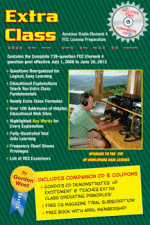
- several questions are variants of each other — once you know the answer to one, you know several. Some of these questions are in different sections of the exam.
- look at what you really need to know to choose the correct answer. Some answers have two or more parts, and only one changes. With others (the phonetic alphabet and resistor color code come to mind) you don't need to know the details, you just need to know that something exists. Others load you with details that aren't important to figuring out the answer.
- mnemonics, those little acronyms, parallels, or other pithy sayings that trigger your memory, are useful. As you work on the material, some should come to you. One benefit of these is that they will stay with you after the exam. A list of some of these is at the bottom of the page. The trick of using mnemonics is that they need to trigger something in your mind; so I have left some of them a bit vague to get you to think.
- sometimes the answer to a question in one section will — if you have come to understand why it's correct — help you with one in another section.
- a few questions are in blocks dealing with the same subject, and sometimes they all have the same answer, or related answers.
- some of the parts will just require memorization — such as the frequency assignments and formulas (although sometimes there is a pattern to the answers that may help; at one point, all of the correct answers in one section of numbers were the second highest choice). We found it helpful to have "cheat sheets" that we could look at during odd moments, for frequent review as the best way to keep them memorized.
- for formulas, it's useful to practice them repeatedly on the calculator that you will take to the session. The familiarity from repeating them will bring them to mind. Have you ever noticed how some people need a telephone keypad to remember a number? They don't know the number, they know the keystrokes.
- write notes (rather than highlighting): writing the material out engages the consciousness and memory more than marking. Review those notes during odd times, especially for things you're having trouble with.
- at least once every four or five days, go through all of the questions, whether you're having trouble with them or not.
- Sherrie found reading and talking about the questions to be more helpful than reading; so you might want to look for a practice partner.

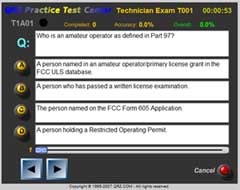 After a couple of weeks, we both used practice exams (available on-line or as software from several providers). There are some good reasons to do this. You need to get away from having whatever study guide you use in front of you, and to think of the answers as part of a real exam. It's very easy to start memorizing the questions and their order, or to skip a question. Taking a practice exam will help insure that you can recall the information without the book (or whatever) in front of you. Along the same lines, a practice exam will help you remember to read the questions and answer carefully before choosing one. On the real exam, the answers can be in any order, and so can the questions. Thus, it is also important to get used to having the items in any order — learning "A" doesn't work, and neither does hoping that a question on one topic will trigger your memory on another. It's important to use the different sites and to take several exams. You may run a practice exam five times but only deal with a few different questions, and that does not provide a good test. Also know where to find the graphics (such as G7-1), as they don't show on some tests.
After a couple of weeks, we both used practice exams (available on-line or as software from several providers). There are some good reasons to do this. You need to get away from having whatever study guide you use in front of you, and to think of the answers as part of a real exam. It's very easy to start memorizing the questions and their order, or to skip a question. Taking a practice exam will help insure that you can recall the information without the book (or whatever) in front of you. Along the same lines, a practice exam will help you remember to read the questions and answer carefully before choosing one. On the real exam, the answers can be in any order, and so can the questions. Thus, it is also important to get used to having the items in any order — learning "A" doesn't work, and neither does hoping that a question on one topic will trigger your memory on another. It's important to use the different sites and to take several exams. You may run a practice exam five times but only deal with a few different questions, and that does not provide a good test. Also know where to find the graphics (such as G7-1), as they don't show on some tests.
Practice exams:
- RadioExam.org; the home page has information about finding exam sessions and costs.
- AA9PW, several options including sending an exam by e-mail and real-world code practice.
- eHam.net, part of a site with a variety of resources.
- QRZ.COM, from another wide-ranging site; a large-print (which includes bold type) option is offered — however, some longer questions are cut off in this option. It presents one question at a time. The frame includes a timer, which I found distracting. On the plus side, you can take several completely different exams in one session. It scores as you go through the questions.
- HamTestOnline, you can take a practice exam free, but there's a fee for other features, such as working on your weak areas, or study guides.
- Copasetic Flow has links to articles explaining each question, free log-in to save and review results, and offers an option to practice individual elements.

(some of) Tim's mnemonics
- 2-4-6-8: length of 1/2 wave dipole antenna: 468/frequency
- silicon (7 letters) diode threshold = 0.7 volts
- germanium (3x3 letters) diode threshold = 0.3 volts
- the above two are examples of linking the number of letters to an answer. At one point, the answer for a question involving NAND (4 letters) was ZERO (also four letters)
- QRQ = send Quicker
- QRS = Slow down
- QRV = ready to receiVe
- capACitors pass AC
- inDuCtors pass DC
- West points out the use of "Darn" or "Daylight," "Eccentric," and "Far" for the ionospheric layers; also note that they're simply in alphabetical order as they go out!
- as an antenna is lowered its feed-point impedance decreases
- Fifteen amp fuse for Fourteen gauge wire (alliteration)
- Twenty amp fuse for Twelve gauge wire (alliteration)
- a particular frequency is often tied to several questions
- when AC frequency increases, a coil springs higher (reactance increases), a capacitor holds back (decreases).
One reason to use at least two different guides and take practice exams is that there are often errors in study materials. When an exam or other source indicates that you've missed a question, go back and look it over. This will help reinforce the correct answer. It may also show that there are some mistakes in the materials you're using.
Please feel free to send any questions; e-mail.
|
